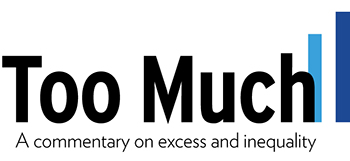If Americans ever really digested the sort of statistics that appear regularly in the IRS research journal, the resulting storm of protest might make the rage over AIG seem about as fearsome as a tantrum from a toddler.
By Sam Pizzigati
Of all the people in the United States, 99.99 percent have never perused the pages of the Statistics of Income Bulletin, a research journal the IRS publishes four times a year. For the power suits on Wall Street, that’s a good thing. If more Americans ever really digested the sort of statistics that appear regularly in this journal, the storm of protest from average Americans might make last week’s rage over AIG seem about as fearsome as a tantrum from a toddler.
The latest edition of the SOI journal popped up earlier this month, with a lead article that looks at who made what back in 2006 — and who paid how much in federal income taxes.
But this article goes on to offer a good bit more than income and tax stats for 2006. The IRS authors have, rather thoughtfully, placed the 2006 income and tax data in a neat historic perspective. They go back 20 years, essentially a generation, and, in the process, tell a gripping story of greed and grasping.
Back in 1986, affluent taxpayers needed to report the equivalent of $118,818 to enter the ranks of the nation’s highest income 1 percent. Average affluents in this top 1 percent, 20 years ago, paid a third of their incomes, 33.1 percent, in federal income tax.
In 2006, by contrast, an annual income of $118,818 wouldn’t get you within shouting distance of the elite top 1 percent. In that year, a taxpayer needed $388,806 to hit the income ladder’s top rung.
But the rich in today’s top 1 percent aren’t just making much more than top 1 percent households made 20 years ago. They’re paying much less of that income in federal income tax. In 2006, the top 1 percent paid a mere 22.8 percent of their incomes to Uncle Sam, down from that 33.1 percent in 1986.
America’s rich have, in effect, seen their tax burden shrink a third since 1986.
Over this same period, the top 1 percent have doubled their share of the nation’s income, from 11.3 percent of the total in 1986 to 22.1 percent in 2006.
And the rest of us? The bottom 90 percent of American taxpayers took in nearly two-thirds of the nation’s income, 64.9 percent, in 1986. The bottom 90 percent’s share in 2006: 52.7 percent, or just over half.
How to explain this vast shift in income from average Americans to Americans at the top? Are rich Americans working harder or longer or smarter than they did two decades ago? Or has their growing wealth simply translated into growing political clout, the power to bend the rules that regulate — or fail to regulate — how our economy operates?
You won’t find an answer to these questions in this latest IRS Statistics of Income Bulletin research. But you will find plenty of reasons to ask them.
Sam Pizzigati edits Too Much, the online weekly on excess and inequality.



Hey, I found your blog while searching on Google your post looks very interesting for me. I will add a backlink and bookmark your site. Keep up the good work!
Amiable dispatch and this enter helped me alot in my college assignement. Say thank you you on your information.
Great post as for me. It would be great to read a bit more concerning this matter. Thank you for giving this material.